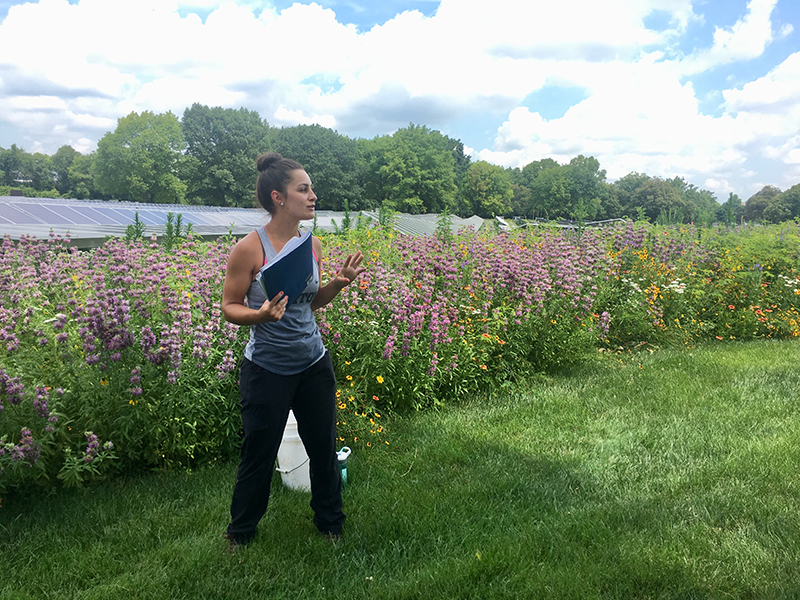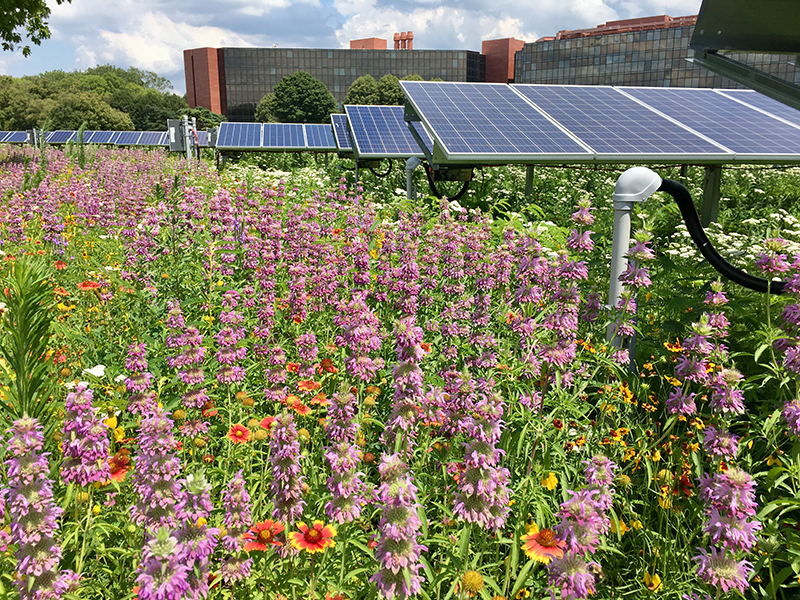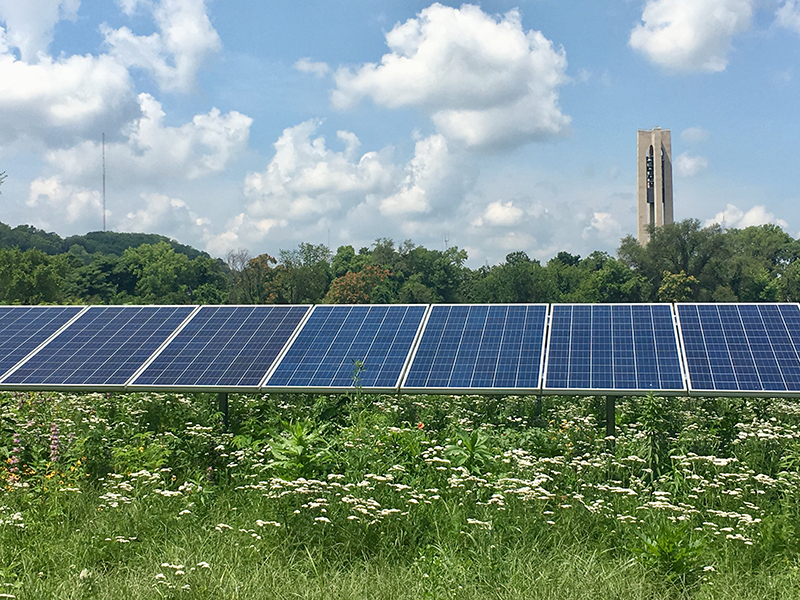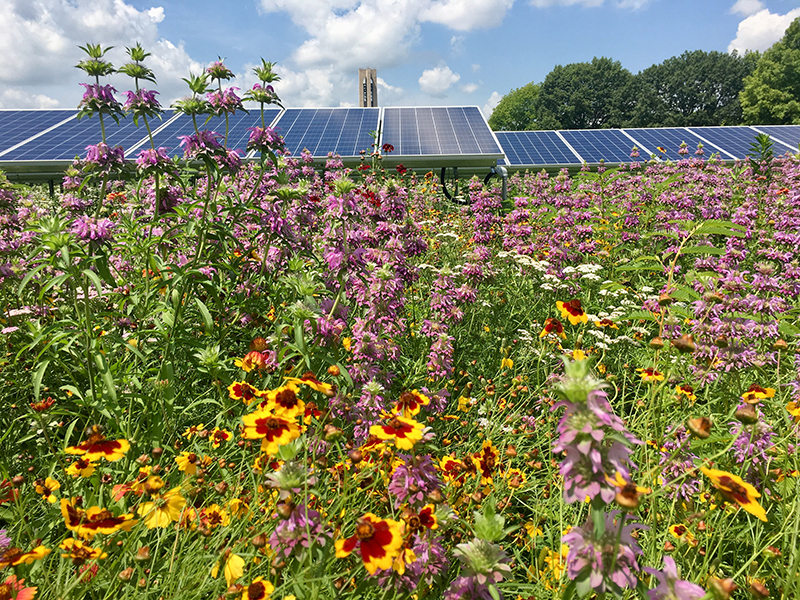Hanley Sustainability Institute

Solar prairie blooms into a 'living laboratory'
By Mark Gokavi
In less than two years, the University of Dayton has transformed the front lawn of Daniel J. Curran Place into a “living laboratory” dedicated to sustainability.
A solar array was installed in 2018 and a pollinator prairie was planted under those panels this spring. Those projects work hand in hand, according to Hanley Sustainability Institute student leader Elise Erhart. The solar prairie is the among the first in Ohio.
Erhart, who graduated in May with an environmental biology major and a minor in sustainability, energy and the environment, said there were three key reasons to plant 81 species of plants on the 6-acre spot at 1700 S. Patterson Blvd.
“The prairie plants have incredibly deep roots. … it makes for adsorption of water,” Erhart said. “It keeps the ground cool. The solar panels run more efficiently with the cooler ground beneath them.”
Erhart said the second reason is that prairie is a declining habitat, especially in the Midwest and West, due to conversion of land for uses such as agriculture and development.
“That creates fragmented habitats … for species that live in the prairie or they use it a lot, that’s very bad for them,” she said, adding that the plants attract wildlife. “It’s already brought in tons of pollinators and we’re very happy about that.”
Erhart said the third reason is for experiential learning for current and future students – a feature echoed by Leah Ceperley, who works for UD's facilities management and the Hanley Institute as sustainability planning and evaluation manager. Solar company Melink agreed not to fence the solar panels, which is not its normal practice and allows students more access to the area.
‘Research, learning and teaching’
“We are in a unique position to use the solar prairie as a living laboratory. We have access to the student solar panels and to the prairie, opening up opportunities for faculty and students to engage the site for research, learning and teaching,” Ceperley said.
Referring to the art and design students creating signage for the site, Ceperley echoed the students’ own words about the value and professional experience this kind of hands-on learning provides. She said students were excited by the challenge of working on a project for a client.
"From my perspective as the client, it was an outstanding outcome to work with and learn from them through the process. And we’re really looking forward to their work coming to fruition,” Ceperley said.
Steve Kendig, the University’s executive director of energy utilization and environmental sustainability, said cross-disciplinary education includes students of clean and renewable energy, biology, graphic arts and design and communications.
‘A visual statement’
“The front of Curran Place was chosen to provide a visual statement to the university's commitment to reduce its carbon footprint and show the community, faculty, staff and students that the university is working to reduce its CO2 emissions,” Kendig said.
Erhart said the idea for a pollinator prairie came from Matthew Worsham, the University’s energy efficiency and renewable energy manager. Erhart said Ceperley immediately championed the idea.
Ceperley said a growing list of more than 40 students have worked on the solar prairie preparing, planting, weeding and caretaking, and in class projects. In addition to the art and design students,, an Internet of Things course developed and installed a wireless sensor network to measure temperatures and soil moisture levels.
Year-round color
Erhart said the solar panels were installed in summer 2018 and started operating in October. She said the moveable panels power about 10 percent of Curran Place and save money.
Several kinds of bees plus butterflies, damselflies, dragonflies, grasshoppers, sparrows, hummingbirds, turtles and numerous other insects have been spotted in the prairie.
Ceperley said the annual native Ohio plants blooming this first summer include partridge pea, lemon mint, coreopsis and gaillardia. She said in subsequent years, native perennial plants will bloom spring, summer and fall to provide color for visitors and nectar for pollinators throughout the growing season. Mowing will be done sparingly.
‘Fantastic collaboration’
Ceperley said partners included UD Grounds, the U.S. Fish and Wildlife Service, the Ohio Pollinator Habitat Initiative, Five Rivers MetroParks and the Marianist Environmental Education Center.
HSI Executive Director Ben McCall noted Ceperley and Worsham – both former HSI graduate assistants – helped grow the solar prairie from idea to realization.
"This has been a fantastic collaboration among facilities, HSI and students," McCall said. "It's a dramatic visual manifestation of the commitment of UD’s leadership to sustainability."




